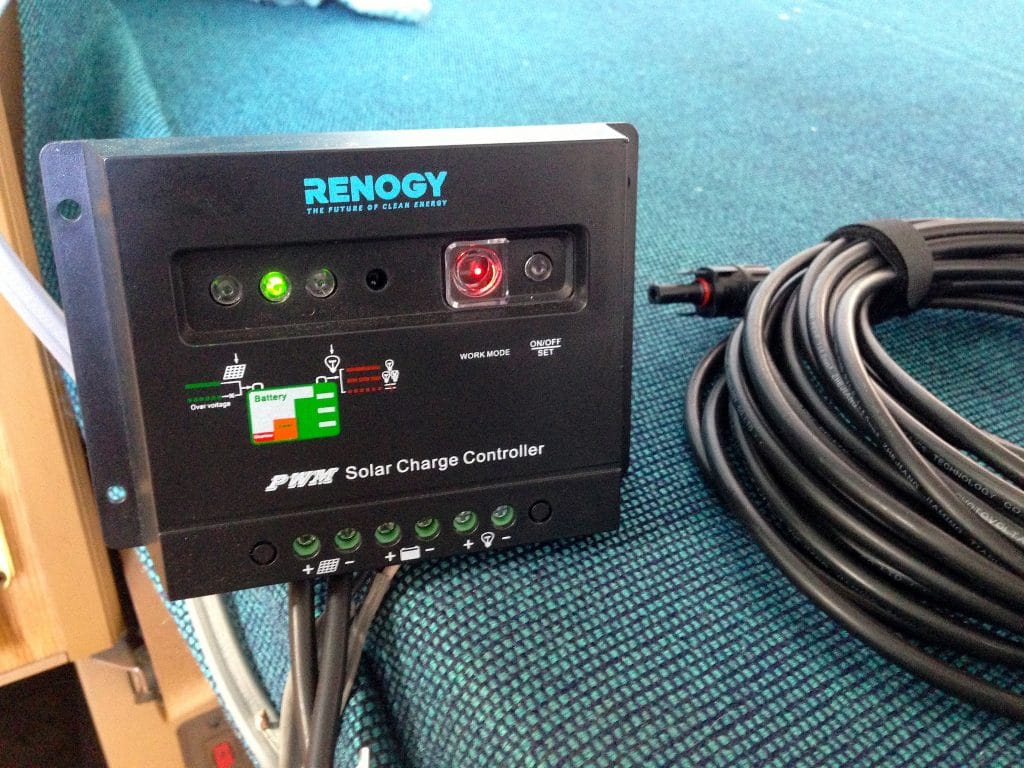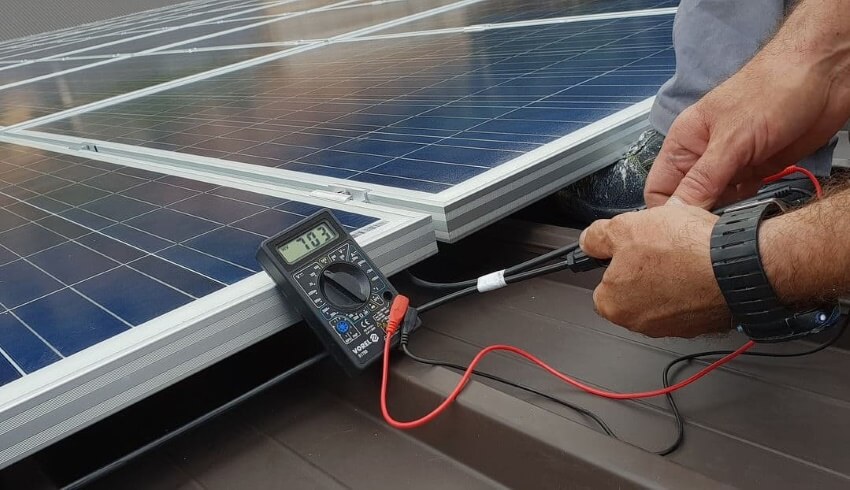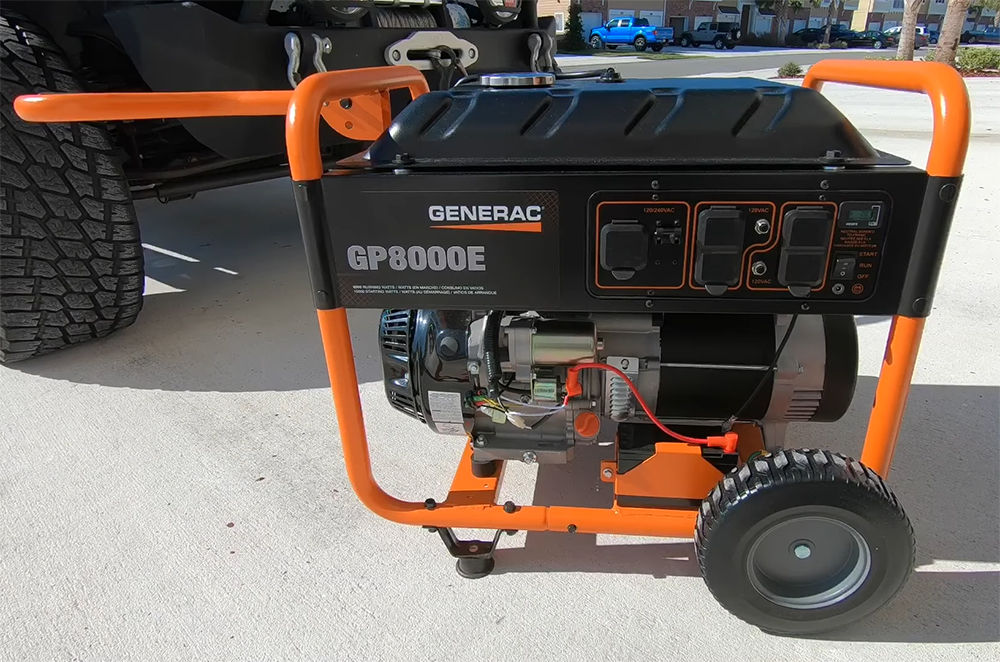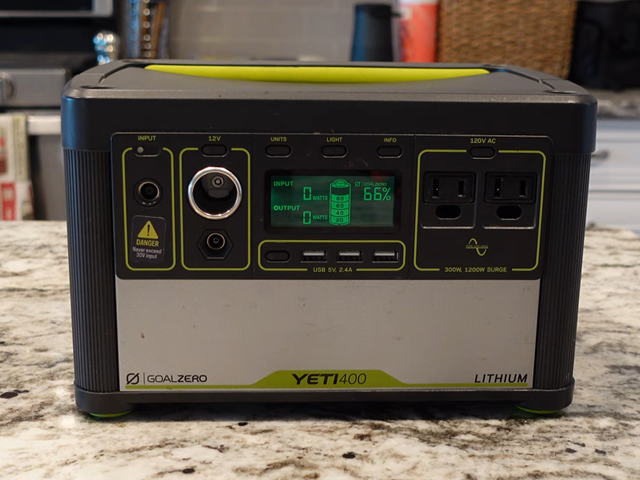
If you’re thinking about setting up a solar power system, whether for your home, RV, or an off-the-grid getaway, you’ll need a solar charge controller. These devices regulate the power transfer from your solar panels to your battery to ensure that your system runs smoothly and safely.
In order to help you find the best solar charge controller, we looked at 32 of the most popular models on the market. The EPEVER 40A MPPT solar charge controller won our Editor’s Choice thanks to the fact that it can be connected to up to four solar panels in series. On top of that, it offers a remote temperature sensor and is capable out putting out current at up to 40 amps. We also gathered up nine other high-quality solar charger controllers to help you find the one that’s best for your solar system.
In choosing the best solar panel charge controllers, we had a lot to consider. We first looked at whether each controller is MPPT-type or PWM-type, which plays a big role in the efficiency of your system. We also considered the battery voltage, input voltage, and output current, since your solar charge controller needs to be sized appropriately for your panels and battery. Overall, we spent tens of hours researching solar charge controllers and reading reviews from solar users. You’ll find all 10 of the controllers we reviewed in the table below, followed by detailed reviews of each. Plus, continue with our buying guide to learn more about choosing the best solar controllers for your needs.
More features: can be connected to up to 4 x 12V solar panels in series; LCD display and Remote Temperature Sensor (RTS) Interface
This solar controller from EPEVER is, in our view, the best MPPT solar charge controller on the market right now. It boasts a 99.5% tracking efficiency and a maximum charge conversion efficiency as high as 98%, so you can be confident that you won’t lose an ounce of power between your solar panels and your batteries.
Another benefit to this solar controller is that it works with a wide variety of solar systems. It supports both lead acid and lithium-ion batteries with up to 12 or 24 volts. On the panel side, the maximum voltage of 100 volts is enough to handle four standard 12-volt panels connected in series. You can easily program the controller to limit the currency output as well if your battery uses less than 40 amps.
Users particularly liked that this solar charge controller comes with a remote temperature sensor interface. That allows it to recognize when your battery is heating up and to cut off charging to prevent damage. That’s a huge advantage since your controller then serves to protect the most important parts of your solar system.
The only issue that users found was that EPEVER’s support could be less than stellar when problems came up. The main issue users reported was the LCD screen turning off after a few months of use, although this was a relatively rare occurrence.
More features: die-cast aluminum design; LCD screen and multiple LED indicators; Bluetooth-compatible and allows the usage of smartphone app
This handy MPPT solar charge controller from Renogy is a close second to the EPEVER charger. It, too, boasts a 99% tracking efficiency and a 98% charge conversion efficiency. On top of that, it works with a wide range of battery types, including sealed, gel, and flooded lead-acid batteries as well as lithium-ion batteries. It even can charge over-discharged lithium-ion batteries, which is a big help if your system experiences an unexpected surge.
The controller is loaded with safety features to prevent that, though. It automatically responds to overcharging, over-discharging, overload, and short-circuiting problems. It also has a built-in semiconductor to eliminate backflow of voltage from your batteries to your solar panels.
The input voltage and current are the same as for the EPEVER controller as well, so it’s compatible with up to four 12-volt panels in series. Users loved the fact that this controller is Bluetooth compatible, so you can check on your system status using the Renogy app on your smartphone. Unfortunately, users were less thrilled with the built-in LCD screen. It doesn’t have a backlight, so it can be very hard to read the information at night, and the LED indicator lights don’t offer much information about what’s happening with your solar system.
More features: built-in Bluetooth via VictronConnect; automatic battery voltage recognition
This charge controller from SmartSolar is slightly more expensive than other options, but part of what you’re paying for is build quality. Users noted that the controller simply feels solid in your hands and that it can stand up to abuse from portable use, such as with an RV, much better than other charge controllers. Over years of use, there were almost no complaints about this controller breaking down or ceasing to work. It’s also versatile, with the ability to work with 12- and 24-volt gel and standard lead acid batteries and lithium-ion batteries.
Users were very happy with the overall efficiency of the solar charge controller, particularly for mid-sized solar systems – it offers a 100-volt maximum input, enough for four small solar panels wired together. There’s no temperature sensor included, but you can purchase one separately and connect it to the controller wirelessly with Bluetooth. Of course, Bluetooth connectivity also allows you to control the voltage and current outputs remotely and to monitor the condition of your solar system.
That said, there’s no LCD screen on this charger, which some users sorely missed. You can install an inline monitor, but that isn’t cheap to do. One other noteworthy issue is that the input ports are very close to one another, opening up the possibility of a short circuit if you’re not careful.
More features: backlit LCD display; OutBack network integration capable; intelligent thermal management cooling; data logging
For large home and commercial solar installations, the Outback Flexmax 80 is one of the best MPPT charge controllers around. This controller has an absolutely massive capacity – it accepts up to 150 volts and 80 amps coming from your solar panel array and can deliver voltage to your battery in 12-volt increments from 12 volts to 60 volts. On top of that, it works with lead-acid and lithium-ion batteries alike.
The LCD screen leaves a few things to be desired if you’re coming from another controller, but this is a minor gripe. One thing users will say for it is that it has a backlight, making it easy to monitor your power status even in the dark.
Importantly for commercial users, the controller is fully capable of data logging and can store up to 180 days’ worth of data. However, it doesn’t come with the data cable or Outback Hub needed to take advantage of this, so plan to spend several hundred dollars more if that’s important to you.
Another thing that users noted was that the controller can run warm, especially on sunny days. It comes with built-in temperature regulation, but it’s a good idea to run a fan nearby to keep cooler air circulating around the unit.
Given the high cost of this unit, you’ll be happy to know that it comes backed by a five-year warranty policy. We haven’t heard of any users reporting issues, but it’s nice to know your purchase is backed up in case anything goes wrong.
More features: Charging Power and Current Limitation functions; user-programmable
This budget-friendly solar charge controller from EPEVER is a great choice for anyone with small solar systems. It’s limited to a maximum current output of just 20 amps, so you’ll need to be careful about connecting this controller to more than one or two solar panels.
That said, the controller is built to be both versatile and durable. It works with lead-acid and lithium-ion batteries of both 12-volt and 24-volt sizes. On top of that, you can program the charging power and current to limit the power flowing to your batteries during specific times. The controller also has a temperature compensation function that protects the battery from being overcharged or over-discharged, which is extremely useful.
The controller’s LCD screen is very easy to read and makes it fairly simple to program the device. However, keep in mind that there’s no way to remotely monitor or control this charge controller since it’s not equipped with Bluetooth. While you can connect it to a computer to update the software and make more advanced programming tweaks, the software is only supported on Windows computers.
Surprisingly, EPEVER doesn’t publish a tracking efficiency or maximum charge conversion efficiency rating for this controller. But, users who have worked with a range of MPPT solar controllers found that it’s impressively efficient for how inexpensive it is.
More features: (2) 5V 2A USB ports; backlit LCD display; Bluetooth-compatible and allows the usage of smartphone app
If you’re looking for the best PWM solar controller to save money, this unit from Renogy is it. It’s extremely simple to operate and offers just enough capacity for small solar systems. In general, you can hook up three 100-watt solar panels to this controller without a problem.
The controller has a number of modern features that you won’t find on a lot of other PWM solar controllers. It’s Bluetooth-enabled and connects to the same Renogy smartphone app as the company’s more modern MPPT controllers. It also has a backlit LCD display, making it easier to monitor the condition of your system. The inclusion of two USB ports is a nice touch, since you can power or charge small electronic devices even when your battery is charging.
To be sure, this solar charge controller is nothing fancy. But users report that it’s reliable, even when using it in relatively hot or cold conditions. In addition, you can program the voltage in small steps for keeping a lithium-ion battery topped off. If you don’t mind the simplicity and inefficiency of a PWM charge controller, there’s plenty to like about this unit.
More features: LCD display; automatic battery voltage recognition
If you’ve got a medium-sized solar system and need more than 100 volts of input capacity, this controller from One-Solar is worth a closer look. It supports both lead-acid and lithium-ion batteries and can switch between four different output voltages: 12, 24, 36, and 48 volts. On top of that, it can handle up to 150 volts of input power, which means that it can be connected to six or more 100-watt solar panels in most systems.
The real advantage of this charge controller is its ability to handle up to 60 amps of current coming from your solar array. Even if your system isn’t producing that much current right now, 60 amps leaves you plenty of room to add panels down the line if you need more power.
Unfortunately, users were less than thrilled with the function of this charge controller in specific circumstances. For lead-acid batteries, the controller only supports float and equalization charging modes. Once it hits the float voltage, it begins to taper current, preventing your battery from ever reaching more than an 80% charge. That’s a huge issue for battery life for anyone using lead-acid batteries.
Another issue to watch out for is that while most users had no problem with this controller for lithium-ion batteries, there are occasional reports of unexpected failure. In one case, a user reported that the controller allowed backfeeding of power from the battery to the panel, causing the panel to burn out. Although the controller is designed with safety features to protect against reverse flow, overcharging, and overheating, it’s a little worrying that this could happen even in a defective unit.
More features: (2) 5V 2A USB ports; backlight LCD display
If you’re on a tight budget and just need a solar controller that can get the job done, this PWM controller from ALLPOWERS is a decent option. It works for both lead-acid and lithium-ion batteries of 12-volt and 24-volt capacities. The 50-volt maximum input voltage isn’t huge, but with 30-amp capacity you should have no trouble using this controller with two standard solar panels hooked up in series.
Importantly, this charge controller has just about everything you need for smooth operation. Four-stage charge management allows you to switch between bulk, float, equalization, and ABS charging. On top of that, there’s a pair of USB ports that you can use to power small electronic devices without draining your battery. The controller is built with heat dissipation mechanisms, so you also don’t have to worry too much on particularly hot and sunny days. That said, ALLPOWERS recommends that you limit this solar controller to indoor use only.
One extra feature that users really liked is that the controller can automatically sense when the sun goes down. When it does, it will automatically turn on any devices you have wired through the controller. If you’re using your solar array to power a set of lights, this is a really helpful option to have.
As far as downsides, there aren’t many – other than the fact that PWM controllers aren’t all that efficient. Users noted that the input ports are on the small side and will just barely fit standard 10-gauge wires.
More features: dual USB output (1A, 2A); temperature sensor; LCD display
It doesn’t get much simpler than this basic and inexpensive PWM solar charger from GHB. It’s fully automatic and features an intelligent control, so that all you have to do is plug it into your battery and solar panels and the controller will do the rest.
Importantly, it automatically provides protection against the most common issues with solar systems and battery charging. You’re protected against overloads, overcharging, short circuits, and even surges from lightning. While the controller can significantly diminish the efficiency of your panels, it does allow you to use maximum amount of the available power to charge your batteries without requiring you to change settings.
Users were happy to find that this charge controller includes a pair of USB ports, which makes it easier to charge small electronic devices. The LCD screen, too, comes with a backlight that makes it easier to read. For the majority of users, there were no hiccups between the charge controller arriving and getting a fully charged battery.
The only downside to this controller, apart from its efficiency, is that it only works with lead-acid batteries. If you have a lithium-ion battery, you’ll need to find a different controller. It also won’t be able to charge or dead batteries, so you need to make sure you don’t run out of power.
More features: built-in Bluetooth via VictronConnect; automatic battery voltage recognition
This 75-volt, 15-amp solar panel charge controller is essentially a smaller and more affordable version of the SmartSolar 100/30 charge controller. It’s one of the best solar charge controllers for RV use, since it’s built with a sturdy casing that can stand up to the knocks of a portable setup and is able to withstand moderate weather conditions. The smaller size is also a plus, since most RV users aren’t running the same large 100-watt solar panels as home users.
The solar charger can work with both lead-acid and lithium-ion batteries and will automatically recognize the voltage of your battery, saving you from worrying about bad settings. The fact that there’s no LCD screen isn’t a huge loss if you’re using this controller on an RV, since you may have it mounted in a hard to access spot on the vehicle. Instead, you can connect the controller to your mobile phone with Bluetooth. This also means that you can keep an eye on your battery charging throughout the day from inside your RV.
That said, users reported some serious issues with the functioning of the Bluetooth connectivity. The controller uses new Bluetooth Low Energy technology, which isn’t widely supported by iOS and Android devices. Worse, even if it does work with your smartphone, the range is limited to just a few feet – so you may have to hold your phone up to the controller just to get a signal.
It’s also important to note that unlike the 100/30 controller, this model doesn’t have a built-in heat sink. If you’re using the controller in a hot environment, like for a summer road trip in the Southwest US, that can be a major problem.
Now that you’ve learned more about our 10 favorite solar charge controllers on the market today, how do you decide which one is right for your solar system? In our buying guide, we’ll explain why you need a solar charge controller and how they work. We’ll also highlight the important features you need to know about when choosing a model.
A solar charge controller isn’t always an essential part of a solar system, but it’s required for the vast majority of setups. This small device is a voltage and current regulator that helps keep your battery from overcharging.
Its main job is to regulate the energy being transferred from the panels to the batteries. That’s necessary because most standard 12-volt panels actually put out 16–20 volts of electricity, which is more than what most standard batteries can handle (14 to 14.5 volts).
However, if you’re using trickle charge panels in the one- to five-watt range, you probably don’t need a solar controller. A good rule of thumb is that if your panels put out less than two watts for every 50 amp-hours your batteries can hold, then you don’t need a solar charge controller.
Solar charge controllers work by modulating the flow of energy from your solar panels to your battery. Depending on your charge controller, it may turn the current from the panels fully on or off, like a switch. Alternatively, most modern pulse width modification controllers reduce or increase the current coming from the panels more gradually.
This is an important function, because overcharging your battery can destroy it. When the voltage entering the battery exceeds its maximum voltage capacity, water separates into hydrogen and oxygen. That not only leads to a loss of water, but the gases can actually cause a small explosion inside your battery and render it useless.
The other thing that a solar controller does is prevent backflow of energy from your battery to your solar panels. Without a solar charge controller, this could happen at night since your panels are essentially an energy sink connected to a reservoir of energy. All controllers have a built-in semiconductor, which only allows charge to flow in one direction – from the panels to the battery.
So, how do you differentiate between different solar panel charge controllers to get the one that’s right for your needs? Here, we’ll take a look at some of the important features that you should know about when choosing a controller.
There are two main types of solar charge controllers on the market today: maximum power point tracking (MPPT) and pulse width modulation (PWM) controllers.
PWM controllers are the older and less expensive style. These controllers are programmed to allow a set current into your battery by repeatedly switching the power flow from the solar panel on and off. When the battery is still charging, it leaves the electrical flow on. However, when the battery reaches capacity, it turns the flow off.
The problem with this system is that it can be inefficient if your panel’s voltage capacity is higher than the battery’s voltage capacity, as is often the case. You may only get 50% of the available wattage in your panels when using a PWM controller.
MPPT controllers are newer and more expensive, but also more efficient. An MPPT controller modulates the voltage and current coming from the panel in order to maximize the charging rate of the battery. So, this is by far the better choice if you have high-wattage panels, such as solar panels on the roof of your home.
It’s important that the battery voltage of your solar charge controller matches the voltage of your battery. Otherwise, you won’t be able to charge your battery completely, which isn’t good for its cycling.
Most batteries fall within a range of 12 to 48 volts, although a large number of the solar charge controllers we reviewed can only support up to 24 volts. If you have a higher-capacity battery for a very large solar system, the Outback solar controller works with batteries up to 60 volts.
Figuring out what input voltage you need from your solar charge controller can be a little bit confusing since most panels don’t run at their rated voltages. That is, a 12-volt solar panel usually runs below 12 volts, so you may be able to get a smaller controller.
In reality, most solar systems require more than the voltage of any single panel. That’s because most people connect multiple panels in a series. In that case, you’ll need to figure out what the maximum voltage of your panel series is and get a solar controller that’s large enough to handle it. Keep in mind that most PWM controllers, like the models from GHB, ALLPOWERS, and Renogy, only support input voltages up to 50 volts. MPPT controllers like the Outback and One-Solar models can support inputs up to 150 volts.
Another thing to keep in mind is that you may want to opt for a larger solar controller than you need. That gives you the flexibility to add additional solar panels to your system in the future if you need more power down the line.

Another important part of sizing your solar charge controller is determining what maximum output current you need. This depends on the maximum potential current that can be produced by your solar panel array. However, there’s a catch – current production by the panels depends on temperature and sunlight intensity, so you need to leave some margin for error.
Thankfully, there are plenty of solar controllers that can handle relatively high currents. Our Editor’s Choice model from EPEVER can handle currents up to 40 amps, as can the Renogy Rover. The Outback controller can handle a whopping 80 amps!
Solar charge controllers are passing electricity between your solar panels and battery, so safety is critical. The majority of controllers we reviewed have LED screens so that you can easily monitor conditions and identify issues with overcharging. In addition, the models from Renogy, SmartSolar, and Victron can be connected to a mobile device via Bluetooth, allowing you to get warnings when there’s a problem with your system.
Another useful safety feature is battery temperature monitoring. This can warn you when your battery is overheating and can automatically shut off the system to prevent damage. You’ll find temperature monitoring on our Editor’s Choice pick from EPEVER.
Depending on your solar setup, it may be easier or harder to get to where your solar charge controller is located. Most modules that we reviewed, with the exception of the Victron and SmartSolar models, are built with LED screens to allow easy monitoring. However, if you want to be able to monitor your charge controller from anywhere in your home, look for a model with Bluetooth. The Renogy, SmartSolar, and Victron models all allow connection with a mobile device.
Bluetooth can also be useful for allowing you to control your solar panel charge controller remotely. In this case, you can turn off power flow or reduce the output current on an as-needed basis.
Solar charge controllers are a big investment – in fact, they can be one of the most expensive components of a new solar system. So, you want to be sure that your controller will stand up to years of use and work reliably. Manufacturers’ warranties can range widely, from two years for the SmartSolar and Renogy controllers to up to five years for the Outback controller. Finding warranty information can be difficult, so make sure to check with the manufacturer if you’re not sure what’s covered.
Your solar charge controller comes with wire adapters that allow you to easily connect it to your solar panel and battery. Importantly, your controller should always be mounted close to your battery, since it needs to be able to accurately measure the voltage in the battery with no drop across the wiring.
Most controllers are designed to be pretty simple to use once they’re set up. You need to adjust the output voltage to match your battery’s voltage, but that’s about it. If you need to make any adjustments to the output current, you can also do that with your controller.
Our three overall favorite solar charge controllers on the market today are the EPEVER 40A MPPT Solar Charge Controller, the Renogy Rover 40 MPPT Solar Charge Controller, and the SmartSolar MPPT 100/30 Charge Controller.
The SmartSolar unit is one of the only ones we reviewed that doesn’t have an LCD screen, but it’s durably built and is equipped with Bluetooth for monitoring and remote control. Helpfully, it also automatically recognizes the voltage of your battery.
The Renogy unit is also equipped with Bluetooth and offers slightly more current, at 40 amps. It’s a great choice for both lead-acid and lithium-ion batteries, although users wished for a backlight on the LCD screen.
We feel the EPEVER 40A MPPT model is the overall best solar charge controller for most solar systems. It offers a very versatile programming range and 40 amps of current, which is plenty for connecting up to four 100-watt solar panels. On top of that, it comes with a temperature monitoring system that can help protect your battery during charging and discharge.





